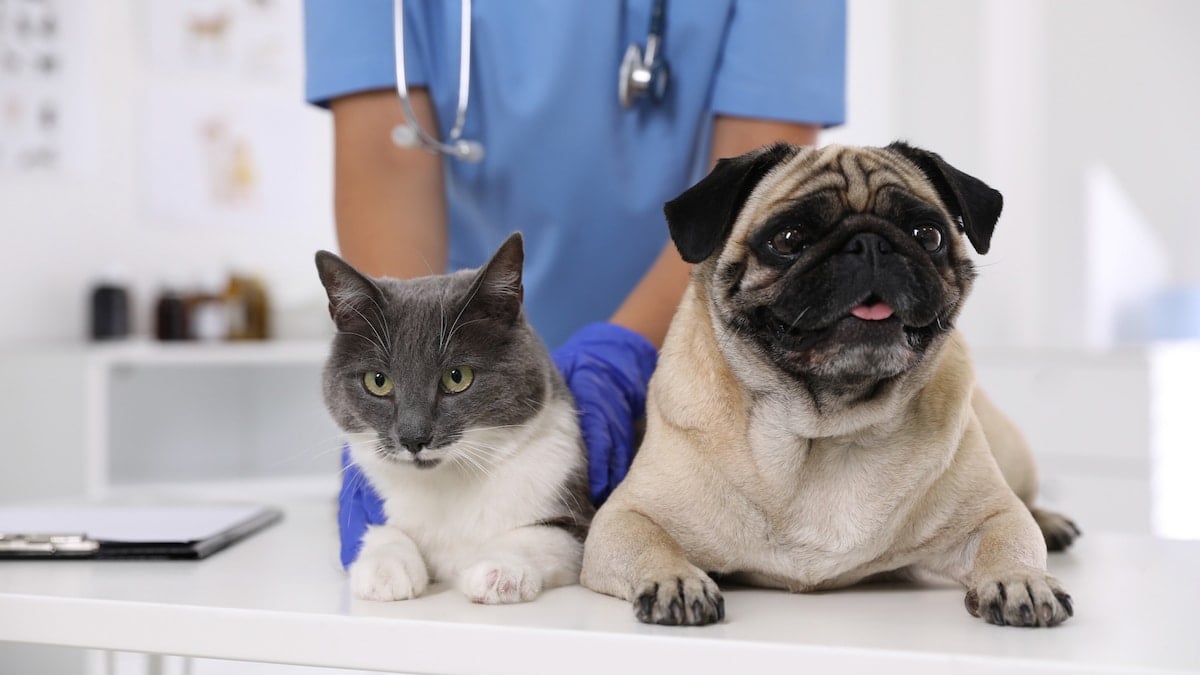- This post contains affiliate links. Read more here.
- Not a substitute for professional veterinary help.
Pet insurance is a good idea for a lot of pets, but choosing a plan and customizing it to your financial needs can be a headache. One of the stumbling blocks many pet parents run into is pet wellness insurance: should you pay for an add-on that covers routine vet visits and preventive care? Fortunately, this is one pet insurance question that’s actually pretty easy to answer. All that’s needed is a little math.
What Is Pet Wellness Insurance?
When you’re shopping for pet insurance, you’ll find that most companies offer a variety of comprehensive “accident and illness” plans—meaning coverage for when your pet gets hurt or sick. These policies typically cover everything from treatment for scrapes and ear infections to surgeries and even cancer (provided none of those things are a pre-existing condition).
What that doesn’t cover is routine and preventive vet care—normal vet visits. It’s an emergency-only kind of approach to insurance that’s focused on protecting you from unexpected pet expenses. But it doesn’t do a thing for the expected ones.
That’s where wellness add-ons come in. Some pet insurance companies offer extra coverage options that you can tack on to your regular insurance for a fee. Wellness insurance is one of the most popular add-ons, and it’s easy to see why. After all, if human healthcare is your model, it seems funny not to have your most basic medical needs covered. Plus, you’re already paying a monthly premium . . . in for a penny, right?
Not right. Wellness add-ons are sometimes a good deal—but not always, and many pet parents are (understandably) too overwhelmed when buying insurance to do the math to figure out if wellness insurance will really save them money.

stocknroll via iStock
What Does Pet Wellness Insurance Cover?
So what are the perks? It varies from company to company, but these are some of the offerings you might find in a wellness package:
- Annual checkups and wellness exams
- Vaccinations and shots
- Flea/tick and heartworm prevention
- Dental cleanings
- Prescription medications and supplements
- Microchipping
- Spaying/neutering
- Annual bloodwork and urinalysis
- Deworming
Different pet insurance companies handle wellness coverage differently, but typically you’ll tack a small sum onto your monthly premium, and in exchange, your insurance company will cover certain categories of routine and preventive care up to specific maximums.
Pets Best, for example, might cover up to $50 in vet exam fees every year and $65 for flea/tick prevention, while you pay $26 per month for this and other wellness coverage. (Note that these numbers may vary depending on your location—these are just examples.) Most wellness insurance isn’t subject to a deductible, and you typically renew it annually.
What Does Pet Wellness Insurance Cost?
The short answer is it depends on your circumstances and your insurance company.
Wellness add-ons tend to see some of the most variation between companies that offer otherwise similar packages, and there are a lot of outliers.
Embrace, for example, nominally offers a wellness add-on, but it’s less like insurance and more like a kind of pet health savings account—they’ll offer you a $25 “reward” for paying money into your plan that will then be reimbursed to you for routine healthcare needs. Whatever you don’t spend doesn’t roll over and isn’t refundable, so it won’t be a good deal for most people. We’d only recommend this add-on if you’re worried you might not effectively budget for your pet’s preventive care without help and strong incentives.

Okssi68 via iStock
Even among the companies that follow the more traditional model (reimbursing you for categories of wellness care up to pre-specified annual maximums), not all agree on what treatments and procedures count. ManyPets, for example, has higher maximums, but their standard wellness insurance doesn’t cover spaying/neutering, microchipping, or fecal and blood tests, while the “BestWellness” plan at Pets Best does.
So how do you figure out which wellness plan is right for you—or even if it’s a good idea at all?
Pet Insurance Versus Wellness Plans: Is Preventive Care a Good Deal?
The short answer is that you don’t start with wellness insurance.
Start by prioritizing accident and illness insurance. A preventive care or wellness plan might save you a hundred dollars here or there, but a good accident and illness insurance policy can save you thousands and protect you from much more severe financial shocks than routine vet bills. It’s more important to choose an insurance company based on their main plan than their supplementary add-ons. (Need help? Check out our article on The Best Pet Insurance Companies: A Pet Parent’s Guide.)
Once you know what company you’d like to enroll with, review the list of routine and preventive procedures your wellness insurance would cover, then put a checkmark next to the ones you expect to need this year. Recall what you’ve paid for them in the past—or give your vet a call and ask them what routine charges might look like, noting the maximums your insurance company won’t exceed.
For example, if your insurance company will only cover up to $150 of teeth cleaning, but you know teeth cleaning is likely to cost you $600, mark the cost down as $150. Add together all the sums your wellness insurance is likely to pay you this year.

Eva Blanco via iStock
Then consider your wellness premiums—the amount you’ll pay monthly for your wellness package. Multiply the monthly rate by 12 to get the amount you would spend on wellness coverage in a year.
Does the sum of your probable covered wellness expenditures exceed what you’d pay in a year for that coverage? If yes, then a wellness add-on is a good investment. If no, skip wellness pet insurance and tackle this one out of pocket. If you change your mind down the road, many companies will let you add a preventive care package later, likely when you renew your regular accident and illness insurance at the end of the year.
Don’t be disappointed if a wellness add-on isn’t a good deal—we’ve found it’s one of the least developed areas of pet insurance, and we hope to see better offerings from companies in the future.
There is, however, one group of pet parents who might want to prioritize wellness and preventive pet insurance, and that’s the puppy and kitten crowd. The list of tests, shots, and procedures (think spaying/neutering and microchipping) that a young pet needs is long.
Some wellness packages, notably the offering from Pets Best, can be a bargain—but it all depends on where you live and your own finances. Our best advice? Do the math, since happily, this is one of the few kinds of insurance where you don’t have to guess.

